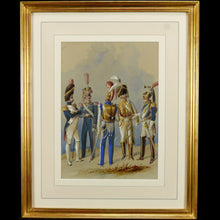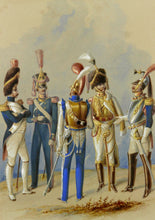French Military Fashion by Heath, 1830
- Regular price
- £1,450
- Sale price
- £1,450
- Regular price
-
- Unit price
- /per
Adding product to your cart
Overall: 49cm (19in) x 40cm (15.7in)
Provenance: Colonel George Powlett Cameron, C.B. (1806–1882)By descent to Air Commodore R. Sorrell-Cameron, C.B.E., A.F.C., (1911-2001)
Watercolour on paper. Officers in review order of the Grenadiers à Pied de la Garde Royale, Artillerie de la Garde Royale, Carabiniers-à-Cheval, Hussards de Ligne, and Cuirassiers. Signed lower right ‘I-I-Ieath ‘Delt’ (abbreviation of the Latin delineavit (he drew). Framed and glazed.
The signature on the present watercolour appears to be ‘I-I-Ieath’ and is interpreted as that of William Heath (1794-1834) - a prestigiously talented military painter, caricaturist and print maker. As a caricaturist he was widely imitated resulting in known signatures to his works. As a military artist he undertook collaborative projects with publishers and undertook private commissions of which the present watercolour is fine example.
Read more
Heath was born in Northumberland and was producing work by the age of fourteen. Despite an apparent absence of any formal training, he was well read and appears to have moved with ease in the louche world of Regency period London. His early works often dealt with military scenes, and included the colour plates for the ‘Martial Achievements of Great Britain and Her Allies; From 1799 to 1815’. He also worked with publisher Daniel Orme in producing the designs for the paper roundels featuring Wellington’s victories. Later caricatures portrayed Wellington the prime minister in a less flatteringly but equally popular light as a lobster, dog and jackass.
In about 1820 he took up residence near Hannah Humphrey's well known print shop at 27 St James's Street, through which he published numerous social satires. Ladies fashion, smoking, drinking, and gambling were the recurring themes that might help explain the accusation that the 29-year-old Heath was a person of extraordinary talents marred by careless habits, drinking, debts, and unpunctuality.
However a best selling project of this period was Heath’s ‘The Life of a Soldier’ (1823) comprising 18 engravings together with a long narrative poem written by the artist. Between 1827 and 1829, many of Heath’s satirical works were published under the pseudonym Paul Pry (from the name of very inquisitive character in a comedy of 1825 by John Poole) with doodle of the character in a lower corner; the figure was soon copied by other caricaturists, and so from 1828 Heath began to sign his work with his name. He was described by the biographer of the caricaturist John Leech as ‘poor Heath, the ex-Captain of Dragoons, facile and profuse, unscrupulous and clever’. By the end of the decade. Heath was living at Shawfield Cottage on Kings Road, Chelsea, or at least that was where he continued the production and publication of military costume watercolours and plates - ‘Military Costume of the British Cavalry’, (c1827) and ‘Costume of the British Army' (1828). It is thought Heath may have sold these over a number of years in volumes with whatever selection the buyer requested. Also at this time, he partnered with the print maker Henry Heath (apparently no relation) to produce the series fancy ‘Costumes and Regimentals of the British Army’ for William Bell’s newly established ‘Gentleman’s Magazine of Fashion’, 1828 to 1831.






